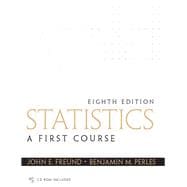
Note: Supplemental materials are not guaranteed with Rental or Used book purchases.
Purchase Benefits
Looking to rent a book? Rent Statistics A First Course [ISBN: 9780130466532] for the semester, quarter, and short term or search our site for other textbooks by Freund, John E., Emeritus; Perles, Benjamin M.. Renting a textbook can save you up to 90% from the cost of buying.
| Introduction | |
| Numerical Data and Categorical Data | |
| Nominal, Ordinal, Interval, and Ratio Data | |
| Sample Data and Populations | |
| Biased Data | |
| Statistics, Past and Present | |
| The Study of Statistics | |
| Statistics, What Lies Ahead | |
| Summarizing Data: Listing and Grouping | |
| Dot Diagrams | |
| Stem-and-Leaf Displays | |
| Frequency Distributions | |
| Graphical Presentations | |
| Summarizing Data: Statistical Descriptions | |
| Measures of Location: The Mean | |
| Measures of Location: The Weighted Mean | |
| Measures of Location: The Median and Other Fractiles | |
| Measures of Location: The Mode | |
| Measures of Variation: The Range | |
| Measures of Variation: The Standard Deviation | |
| Some Applications of the Standard Deviation | |
| The Description of Grouped Data | |
| Some Further Descriptions | |
| Technical Note Summations | |
| Review: Chapters 1,2, & 3 | |
| Possibilities and Probabilities | |
| Counting | |
| Permutations | |
| Combinations | |
| Probability | |
| Mathematical Expectation | |
| A Decision Problem | |
| Some Rules of Probability | |
| The Sample Space | |
| Events | |
| Some Basic Rules of Probability | |
| Probabilities and Odds | |
| Addition Rules | |
| Conditional Probability | |
| Independent Events | |
| Multiplication Rules | |
| Bayes' Theorem | |
| Review: Chapters 4 & 5 | |
| Probability Distributions | |
| Probability Distributions | |
| The Binomial Distribution | |
| The Hypergeometric Distribution | |
| The Poisson Distribution | |
| The Multinomial Distribution | |
| The Mean of a Probability Distribution | |
| The Standard Deviation of a Probability Distribution | |
| Chebyshev's Theorem | |
| The Normal Distribution | |
| Continuous Distributions | |
| The Normal Distribution | |
| Some Applications | |
| The Normal Approximation to the Binomial Distribution | |
| Sampling and Sampling Distributions | |
| Random Sampling | |
| Sampling Distributions | |
| The Standard Error of the Mean | |
| The Central Limit Theorem | |
| Review: Chapters 6, 7, & 8 | |
| Problems of Estimation | |
| The Estimation of Means | |
| Confidence Intervals for Means | |
| Confidence Intervals for Means (Small Samples) | |
| Confidence Intervals for Standard Deviations | |
| The Estimation of Proportions | |
| Tests Concerning Means | |
| Tests of Hypotheses | |
| Significance Tests | |
| Tests Concerning Means | |
| Tests Concerning Means (Small Samples) | |
| Differences Between Means | |
| Differences Between Means (Small Samples) | |
| Differences Between Means (Paired Data) | |
| Differences Among k | |
| Means | |
| Analysis of Variance | |
| Tests Based on Count Data | |
| Tests Concerning Proportions | |
| Tests Concerning Proportions (Large Samples) | |
| Differences Between Proportions | |
| Differences Among Proportions | |
| Contingency Tables | |
| Goodness of Fit | |
| Review: Chapters 9, 10, & 11 | |
| Regression and Correlation | |
| Curve Fitting | |
| The Method of Least Squares | |
| Regression Analysis | |
| The Coefficient of Correlation | |
| The Interpretation of r | |
| A Significance Test for r | |
| Nonparametric Tests | |
| The One-Sample Sign Test | |
| The Paired-Sample Sign Test | |
| The Sign Test (Large Samples) | |
| Rank Sums: The U | |
| Test | |
| Rank Sums: The U Test (Large Samples) | |
| Rank Sums: The H | |
| Test | |
| Tests of Randomness: Runs | |
| Tests of Randomness: Runs (Large Samples) | |
| Tests of Randomness: Runs Above and Below the Median | |
| Rank Correlation | |
| Review: Chapters 12 & 13 | |
| TI-83 Tips | |
| Bibliography | |
| Statistical Tables | |
| Answers to Odd-Numbered Exercises | |
| Index | |
| Table of Contents provided by Publisher. All Rights Reserved. |
The New copy of this book will include any supplemental materials advertised. Please check the title of the book to determine if it should include any access cards, study guides, lab manuals, CDs, etc.
The Used, Rental and eBook copies of this book are not guaranteed to include any supplemental materials. Typically, only the book itself is included. This is true even if the title states it includes any access cards, study guides, lab manuals, CDs, etc.